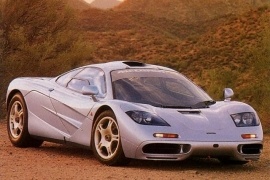MCLAREN F1 Models/Series Timeline, Specifications & Photos
First production year: 1993
Engines: Gasoline
Body style: Coupé (two-door)
The 1993 McLaren F1 was considered the first true hypercar, even though that term had yet to be invented, and it showed the world what the finest automotive engineering minds could make when put together.
McLaren was the dominant team in the late ‘80s. Besides the 1987 season, it won all championships between 1984 and 1991. The British company had already developed the process of molding and using carbon fiber in Formula 1, and it was winning race after race. Then, in 1988, the team’s principal, Ron Dennis, greenlit the project of creating a supercar like no other. McLaren F1’s Technical Director, Gordon Murray, was responsible for it. He drew his inspiration from the Honda NSX (the team’s engine supplier at that time) and the F16 fighter jet. One year later, in March 1989, the first prototype of the car, named the XP5, set the record for the fastest production car in the world with a staggering speed of 240.1 mph (386,4 km/h), and that was just the beginning of the glorious story of the McLaren F1. The car manufacturer approached Honda to deliver the engine, but they couldn’t cut a deal. As a result, Gordon Murray approached BMW, which built the mighty S70/2 V12 engine, especially for this car. It took McLaren 6,000 man-hours to build a vehicle from scratch to the finished product.
The car’s front sat low and looked like nothing else in the supercar world. Its oval-shaped scoops on the bumper fed cold air to the brakes to cool them. A center air intake also grabbed air to cool the radiator behind it, while the tiny trapezoidal-shaped lid that covered the front storage compartment featured an additional air intake on its upper side. The headlights were covered by clear glass lenses to lower the F1’s drag coefficient.
From its profile, the mid-engine hypercar revealed its balanced design with a short nose and arched greenhouse that resembled the canopy of an F16 fighter jet. The A-pillars resembled those from the Honda NSX. Gordon Murray also added extracting vents that were mounted upwards to increase downforce. A tiny scoop on the roof fed the engine mounted behind the cabin with fresh air. Surprisingly, the automaker considered there was no need for a wing at the back of the car since that would increase drag resistance. There was only one small flap that was deployed during hard braking. Finally, at the back, the automaker installed four round taillights on the upper side, while the lower area was dominated by a massive diffuser. Between them, in a central position, the automaker placed the four exhausts. Everything had a purpose for the car, and nothing was added just to make it look good. It didn’t need to.
While the exterior was somehow shocking, with the usual proportions for such a high-speed vehicle, the interior was unique. Unlike any other supercar on the market, it featured a central driving position. The butterfly-style doors allowed ingress and egress over the wide side sills, part of the vehicle’s chassis. Left and right to the driver, but rearward, the automaker added a pair of sports seats for the occasional passengers. Fronting the steering wheel was an instrument cluster where the tachometer took center stage. It was flanked by a large speedometer on the right and three gauges on the left, grouped into one dial. A CD stereo was also installed. Surprisingly, the car even had a luggage compartment on the driver’s side.
Under the massive rear window, the automaker placed the majestic V12 engine. Even though it exceeded Murray’s specifications about weight, it compensated with its power and relentless ability to rev high. Its titanium exhausts were lighter than steel ones and produced a fantastic sound. The massive 627 hp were sent to the rear wheels via a six-speed manual, rocketing the car from naught to 100 kph (0-62 mph) in a mere 3.2 seconds onto its way to a top speed of a declared 231 mph (372 kph). At that speed, the engine met the rev-limiter. The record-holder XP5 had that raised a bit to pass the 240 mph mark.
